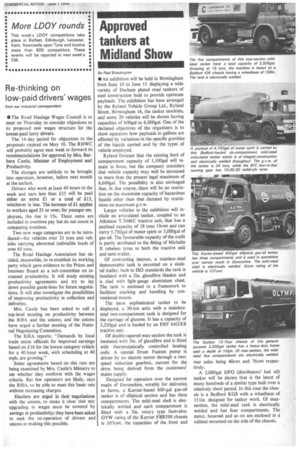Approved tankers at Midland Show
Page 43

If you've noticed an error in this article please click here to report it so we can fix it.
By Paul Brockington
• An exhibition will be held in Birmingham from June 10 to June 15 displaying a wide variety of Darham plated road tankers of steel construction built to provide optimum payloads. The exhibition has been arranged by the Ryland Vehicle Group Ltd., Ryland Street, Birmingham 16, the tanker stockists, and some 20 vehicles will be shown having capacities of 600gal to 6,000gal. One of the declared objectives of the organizers is to show operators how payloads in gallons are affected by variations in the specific gravities of the liquids carried and by the types of vehicle employed.
Ryland forecast that the existing limit of compartment capacity of 1,100gal will re main in force, but the company considers that vehicle capacity may well be increased to more than the present legal maximum of 6,600gal. The possibility is also envisaged that, in due course, there will be no restriction on the maximum capacity of hazardous liquids other than that dictated by restrictions on maximum g.v.w.
Larger vehicles in the exhibition will include an articulated tanker, coupled to an Atkinson T.3046C tractive unit, that has a payload capacity of 18 tons Newt and can carry 5,750gal of motor spirit or 5,000gal of gas oil. The favourable capacity of the outfit is partly attributed to the fitting of Michelin X tubeless tyres to both the tractive unit and semi-trailer.
Of contrasting interest, a stainless-steel demountable tank is mounted on a skele tal trailer; built to ISO standards the tank is insulated with a 2in. glassfibre blanket and is clad with light-gauge aluminium sheet.
The tank is enclosed in a framework to facilitate stacking and handling by conventional means.
The most sophisticated tanker to be displayed. a 30-ton artic with a stainless
steel two-compartment tank is designed for the carriage of glucose. It has a capacity of 3,250gal and is hauled by an FRF 64GXB tractive unit.
Of double-tapered max-section the tank is insulated with 3in. of glassfibre and is fitted with thermostatically controlled heating coils. A special Drum Fastnet pump is driven by an electric motor through a two speed reduction gearbox, current for the drive being derived from the customers' mains supply.
Designed for operation over the narrow roads of Devonshire, notably for deliveries to farms, a Karrier-based 600-gal gas-oil tanker is of elliptical section and has three compartments. The mild-steel shell is elec trically welded and each compartment is fitted with a 3in. rotary type footvaive. GVW rating of the Karrier FBB398 chassis is 107cwt, the capacities of the front and rear axles being 40cwt and 76cwt respectively.
A 2,000gal DFO (distributors' fuel oil) tanker will be shown that is the latest of many hundreds of a similar type built over a relatively short period. In this case the chassis is a Bedford KGS with a wheelbase of 151in. designed for tanker work. Of maxsection, the mild-steel tank is electrically welded and has four compartments. The meter, hosereel and so on are enclosed in a cabinet mounted on the side of the chassis.
















































































































































